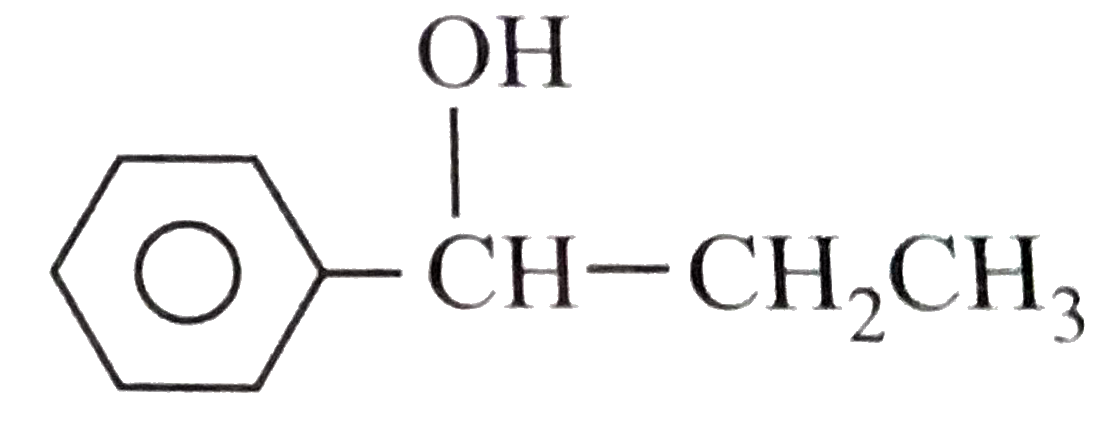The final product (C ) obtained in the reaction sequence is




The correct Answer is:C
To solve the given reaction sequence, we will go through each step systematically.
Step 1: Reaction of Propanoic Acid with PCl3
The first step involves the reaction of propanoic acid (CH₃CH₂COOH) with phosphorus trichloride (PCl₃).
Reaction:
CH3CH2COOH+PCl3→CH3CH2C(=O)Cl+HCl+POCl3
Product A:
The product formed is propanoyl chloride (CH₃CH₂C(=O)Cl).
Step 2: Friedel-Crafts Acylation
Next, we take the product A (propanoyl chloride) and react it with benzene (C₆H₆) in the presence of anhydrous aluminum chloride (AlCl₃). This reaction is known as Friedel-Crafts acylation.
Reaction:
CH3CH2C(=O)Cl+C6H6AlCl3−−−→C6H5C(=O)CH2CH3+HCl
Product B:
The product formed is phenyl propanoyl (C₆H₅C(=O)CH₂CH₃).
Step 3: Hydrazine Reaction
In the final step, we react product B (phenyl propanoyl) with hydrazine (NH₂NH₂) in the presence of a base and heat. This reaction is known as the Wolff-Kishner reduction.
Reaction:
C6H5C(=O)CH2CH3+NH2NH2Base, Heat−−−−−−→C6H5CH2CH3+N2+H2O
Product C:
The final product C is phenyl ethane (C₆H₅CH₂CH₃).
Summary of Products:
- Product A: Propanoyl chloride (CH₃CH₂C(=O)Cl)
- Product B: Phenyl propanoyl (C₆H₅C(=O)CH₂CH₃)
- Product C: Phenyl ethane (C₆H₅CH₂CH₃)
Final Answer:
The final product (C) obtained in the reaction sequence is C₆H₅CH₂CH₃.
---
The first step involves the reaction of propanoic acid (CH₃CH₂COOH) with phosphorus trichloride (PCl₃).
CH3CH2COOH+PCl3→CH3CH2C(=O)Cl+HCl+POCl3
The product formed is propanoyl chloride (CH₃CH₂C(=O)Cl).
Next, we take the product A (propanoyl chloride) and react it with benzene (C₆H₆) in the presence of anhydrous aluminum chloride (AlCl₃). This reaction is known as Friedel-Crafts acylation.
CH3CH2C(=O)Cl+C6H6AlCl3−−−→C6H5C(=O)CH2CH3+HCl
The product formed is phenyl propanoyl (C₆H₅C(=O)CH₂CH₃).
In the final step, we react product B (phenyl propanoyl) with hydrazine (NH₂NH₂) in the presence of a base and heat. This reaction is known as the Wolff-Kishner reduction.
C6H5C(=O)CH2CH3+NH2NH2Base, Heat−−−−−−→C6H5CH2CH3+N2+H2O
The final product C is phenyl ethane (C₆H₅CH₂CH₃).
- Product A: Propanoyl chloride (CH₃CH₂C(=O)Cl)
- Product B: Phenyl propanoyl (C₆H₅C(=O)CH₂CH₃)
- Product C: Phenyl ethane (C₆H₅CH₂CH₃)
The final product (C) obtained in the reaction sequence is C₆H₅CH₂CH₃.
Topper's Solved these Questions
- ALDEHYDES, KETONES AND CARBOXYLIC ACIDSBook:NCERT FINGERTPS ENGLISHChapter:ALDEHYDES, KETONES AND CARBOXYLIC ACIDSExercise:NCERT ( EXEMPLAR PROBLEMS )
Explore 11 Videos
- ALDEHYDES, KETONES AND CARBOXYLIC ACIDSBook:NCERT FINGERTPS ENGLISHChapter:ALDEHYDES, KETONES AND CARBOXYLIC ACIDSExercise:ASSERTION & REASON
Explore 15 Videos
- ALDEHYDES, KETONES AND CARBOXYLIC ACIDSBook:NCERT FINGERTPS ENGLISHChapter:ALDEHYDES, KETONES AND CARBOXYLIC ACIDSExercise:MCQs( PHYSICAL PROPERTIES )
Explore 2 Videos
- ALCOHOLS,PHENOLS AND ETHERSBook:NCERT FINGERTPS ENGLISHChapter:ALCOHOLS,PHENOLS AND ETHERSExercise:Assertion And Reason
Explore 14 Videos
- AMINES Book:NCERT FINGERTPS ENGLISHChapter:AMINES Exercise:ASSERTION & REASON CORNER
Explore 14 Videos
Similar Questions
Knowledge Check
In a set of the given reactions, acetic acid yielded a product iC.
CH3COOH+PCl5→AC6H6−−−−−−→Anh.AlCl3BC2H5MgBr−−−−−−→etherC
Product C would beACH3CH(OH)C2H5BCH3COC6H5CCH3CH(OH)C6H5DCH3− C2H5∣C(OH)C6H5Identify product D in the following reaction sequence :
CH_(3)-overset(CH_(3))overset(|)underset(CH_(3))underset(|)(C )-CH_(2)CH_(2)Ohoverset(K_(2)Cr_(7)O_(7),H_(2)SO_(4))underset(H_(2)O, "heat")(to)Aoverset(SOCl_(2))(to)Boverset((CH_(3))_2)NH)underset((2"mole"))(to)Coverset(1.LiAlH_(4))overset("diethyl ether")underset(2.H_(2)O)(to)DACH3CH3∣C∣CH3CH2C≡NBCH3CH3∣C∣CH3CH2N(CH3)2CCH3CH3∣C∣CH3CH2N(CH3)2∣CHN(CH3)2DCH3CH3∣C∣CH3CH2C∣OHHN(CH3)2Identify (X), (Y) andc (Z) in the given reaction :
CH3CHOK2Cr2O7−−−−−→H2SO4(X)PCl5−−→(Y)C6H6−−−−−→anh.AlCl3(Z)A(X)=HCOOH,(Y)=COCl2,(Y)=COCl2,(Z)=C6H5ClB(X)=CH3COOH,(Y)=CH3COCl,(Z)=C6H5COCH3C(X)=CH3COOH,(Y)=CH3CH2CH2Cl,(Z)=C6H5CH2CH2CH3D(X)=CH3COCH3,(Y)=CH3CHClCH3,(Z)=C6H5COCH3
What is the end product in the following sequence of reactions?
C2H5NH2HNO2−−−→A−−→PCl2B−−→NH3C
View SolutionThe major product of the following reaction is :
C6H5CH2−CH3∣C∣Br=CH2−CH3C2H5ONa−−−−−→C2H5OH
View SolutionThe major product of the following reaction is :
C6H5CH2−CH3∣C∣Br−CH2−CH3C2H5ONa−−−−−→C2H5OH
View SolutionMajor product of the given reaction is
CH3−CH3∣C∣CH3−CH∣CI−CH3C2H5O−−−−−−→
View SolutionIdentify the product A,B,C and D
C6H6CH3Cl−−−−−−−−→Anhyd. AlCl3ACrO2Cl2−−−−→CCl4BConc.−−−→NaOHC+D.
View Solution
